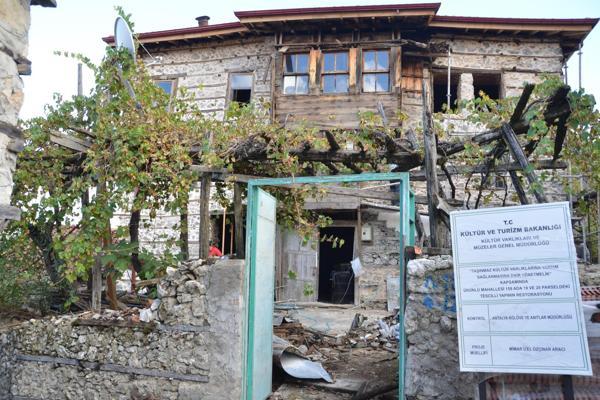Antalya’s unique houses under restoration
ANTALYA


Antalya’s historical Düğmeli (buttoned) houses, some of which serves as hotels and souvenir shops, are undergoing restoration works with the support of the Culture and Tourism Ministry.
The structures, restored in accordance with their historical texture under the control of the Antalya Survey and Monuments Directorate, serve as museums, hotels, houses, mansions, souvenirs and places where local products are sold.
They are described as buttoned houses because the wooden parts outside that were used as scaffolding during their construction resemble buttons. They are among the most visited places by tourists in the southern Turkish city.
Hüda Onay, the owner of an approximately 300-year-old two-story buttoned house that she inherited from her father in the Ürünlü neighborhood and is under restoration, said that their house was taken under protection in 2009 and that a project was designed for its restoration two years ago.
Onay said that 40,000 Turkish Liras were provided by the ministry during the project phase, adding: “Our house was idle and uninhabitable. After the approval of our restoration project, we initiated work. The two-story house will be a five-room boutique hotel. It is known that this house is approximately 300 years old. We designed the project with the contributions and support of the ministry. The project is almost ready. Our goal is to protect our heritage from our ancestors. We received 1 million liras of support from the Culture Ministry. And also 40,000 liras of support was given during the project planning phase. We plan to open it as a boutique hotel and restaurant. There are three more houses in our village that are still under restoration. Their restoration will be completed soon, too.”
Hilmi Bilgen, a restorer with 20 years of experience, said he has been working on the restoration of buttoned houses in the region.
“I carry out restoration and plastering works. The houses are historical buttoned houses. These houses were idle and uninhabitable. With the support of the ministry, these historical houses are being restored. This a difficult and troublesome process. The stones are cleaned, brushed, jointed and filled. We are very careful not to damage the originality of the structures during the restoration. We assemble exactly the same wooden decorative structures made of cedar wood,” he said.
Gülsüm Özdemir, who lives in the Ürünlü neighborhood, said that she had the restoration done of the three-story button house inherited from her ancestors with the support of the ministry, too.
“I am 70 years old. We started the restoration process in our buttoned house. Our historical house was registered and protected in 2009. This house dates back to 400 years. My house is one of the oldest houses in the village. It has 10 rooms. We have not been able to make any renovations so far. Thanks to the ministry, our project was approved and an allowance of 1.2 million lira was allocated. I will leave this historical house inherited from my ancestors as a cultural heritage to my children and grandchildren,” she said.
Former mukhtar of Ürünlü district, Nutfullah Murat Yamansoy said, “We have 29 registered buttoned houses in Ürünlü. Some of our buttoned houses generally consist of two floors. There are five three-story buttoned houses that are nearly 400 years old. Five of the projects commissioned by the owners of buttoned houses were approved by the Culture and Tourism Ministry this year. The restoration of three of them is currently ongoing.”
The name of the buttoned houses, which reflect traditional Ottoman architecture in the İbradı and Akseki districts of Antalya, comes from their architecture. Wood cut from the cedar tar tree is used as a skeleton, interlocking with each other. Mortar and cement are not used in the stones piled on the building. Since the outer parts of the skeleton look like buttons, they are called buttoned houses.
